Current Status of AF Management and the Role of Catheter ablation
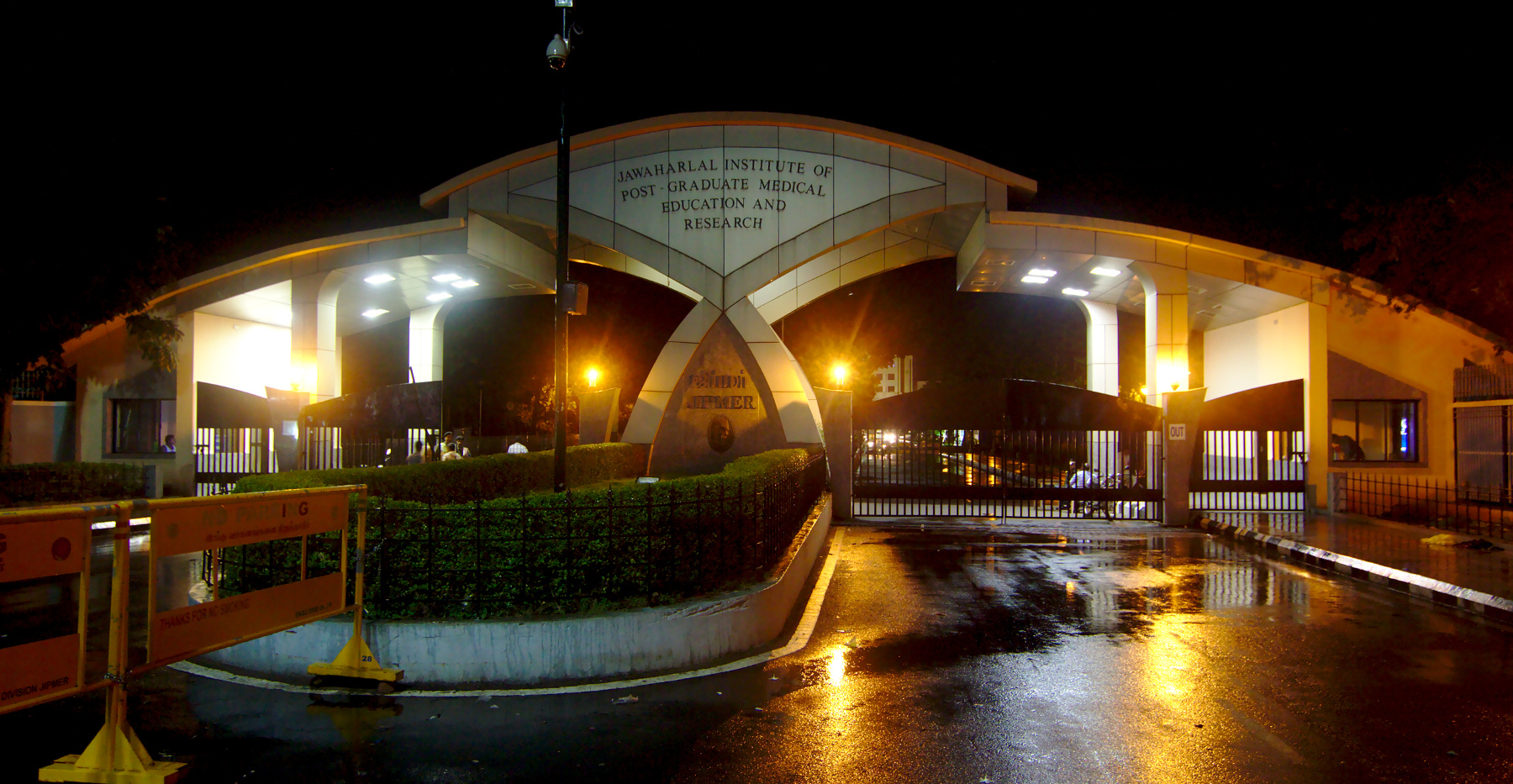
Raja Selvaraj, JIPMER
Introduction
Prevalence
- 3% of adults 20 y of age and older (1)
- Worldwide 20.9 and 12.6 million men and women affected (2)
- Haim et al. Prospective national study of the prevalence, incidence, management and outcome of a large contemporary cohort of patients with incident non-valvular atrial fibrillation. J Am Heart Assoc 2015; 4 :e001486
- Chugh et al. Worldwide epidemiology of atrial fibrillation: A Global Burden of Disease 2010 Study. Circulation 2014;129:837 – 847.
Morbidity due to AF
- Cause of 20-30% of all strokes
- LV dysfunction and failure in 20-30%
- Impaired QOL independent of other factors
- Cognitive impairment
AF and mortality
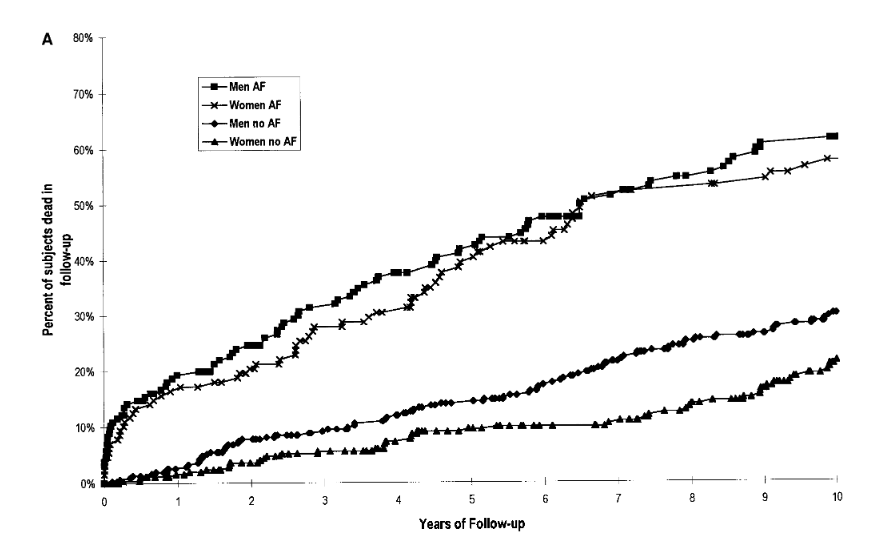
Benjamin et al. Impact of atrial fibrillation on the risk of death: the Framingham Heart Study. Circulation 1998; 98:946 – 952.
Identification of AF
Asymptomatic AF
- Silent AF is common
- 12% in AFFIRM (1)
- At least one third of patients with AF are asymptomatic (2)
- Significant risk of stroke and death
- Flaker GC, Belew K, Beckman K, Vidaillet H, Kron J, Safford R, Mickel M, Barrell P. Asymptomatic atrial fibrillation: demographic features and prognostic information from the Atrial Fibrillation Follow-Up Investigation of Rhythm Management (AFFIRM) study. Am Heart J. 2005;149:657–663.
- Clinical Relevance of Silent Atrial Fibrillation: Prevalence, Prognosis, Quality of Life, and Management. Journal of Interventional Cardiac Electrophysiology 2000, Volume 4,pp 369–382.
Community level and Opportunistic screening
- Target older patients - 65 yrs / 75 yrs
- About 2% of patients above 65 yrs of age
- Short term ECG / pulse palpation / smartphone apps
Smartphone detection of AF
- Using photoplethysmography
- 12,328 patients recruited by newspaper ad
- Two measurements daily for 7 days
- AF identified in 1.1% overall, 11% for those older than 80 yrs
Vandervoort PM. Digital-AF. Late-Breaking Science in Telemedicine. Presented at: European Society of Cardiology Congress; Aug. 25-29, 2018; Munich.
Fibricheck
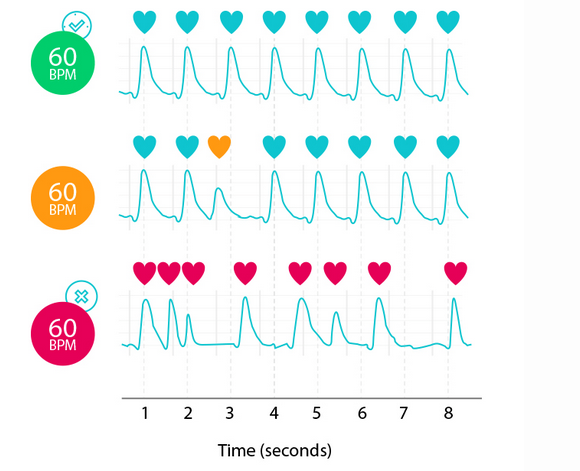
Device detected AF
- Atrial high rate episodes in pacemakers
- Increased risk of ischemic stroke or systemic embolism (HR 2.49)
- Longer AHRE episodes (5 min)
- Evaluate for thrombo-embolic risk
- Evaluate for AF
Stroke survivors
- AF identified by long term rhythm monitoring in 11.5% of patients (1)
- May need prolonged monitoring with loop recorders
- Most useful in cryptogenic stroke
- Prolonged monitoring reasonable in ischemic stroke survivors without known cause
- Kishore et al. Detection of atrial fibrillation after ischemic stroke or transient ischemic attack: a systematic review and meta-analysis. Stroke 2014; 45:520 – 526
Anticoagulation
Risk estimation
- CHA2DS2-VASc score
- Female sex alone does not confer risk
- OAC for score more than 1 (men) or 2 (women)
- OAC should be considered for risk score of 1 (men) or 2 (women)
Non Vit K antagonist Oral Anticoagulants
- More predictable effect
- In general, similar efficacy to Warfarin in reducing thromboembolic events
- Less bleeding, especially hemorrhagic strokes
Antiplatelets
- Less effective than Warfarin (1)
- High bleeding risk, equal to Warfarin with dual antiplatelets (2)
- Not recommended
- Connolly et al. Clopidogrel plus aspirin versus oral anticoagulation for atrial fibrillation in the Atrial fibrillation Clopidogrel Trial with Irbesartan for prevention of Vascular Events (ACTIVE W): a randomised controlled trial. Lancet 2006; 367 :1903 – 1912.
- Connolly et al. Effect of clopidogrel added to aspirin in patients with atrial fibrillation. N Engl J Med 2009; 360 :2066 – 2078
Living with AF (rate control)
Rate vs rhythm - Metanalysis
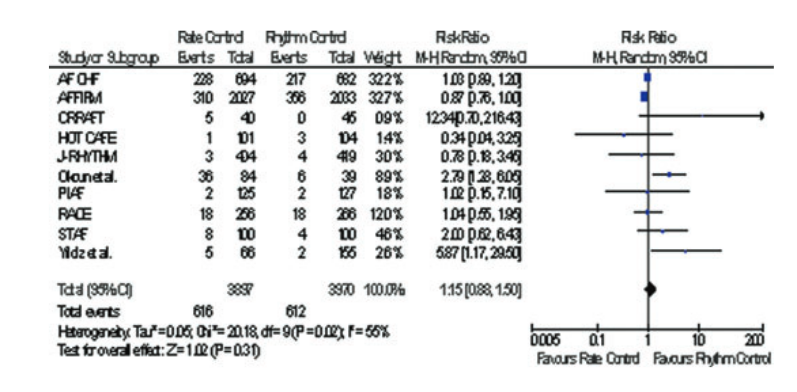
Pharmacologic Rate versus Rhythm‐Control Strategies in Atrial Fibrillation: An Updated Comprehensive Review and Meta‐Analysis. PACE 2013; 36:122–133
Modified European Heart Rhythm Association symptom scale
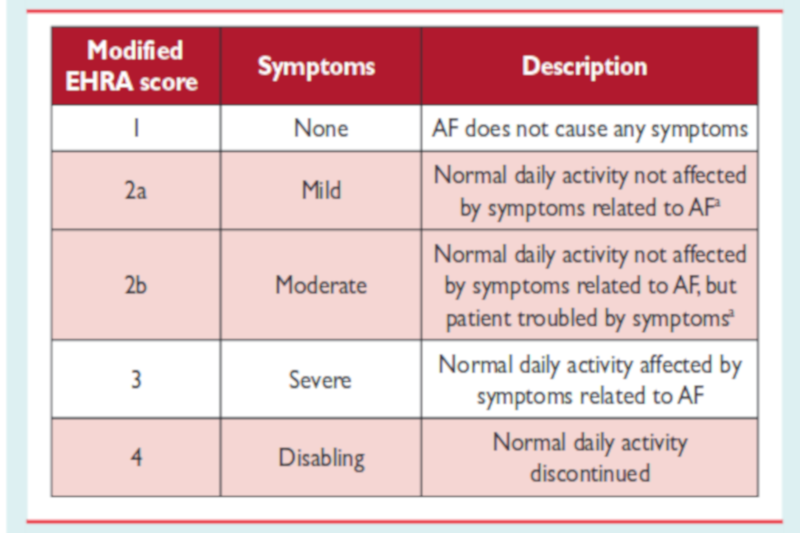
Target for rate control - RACE II
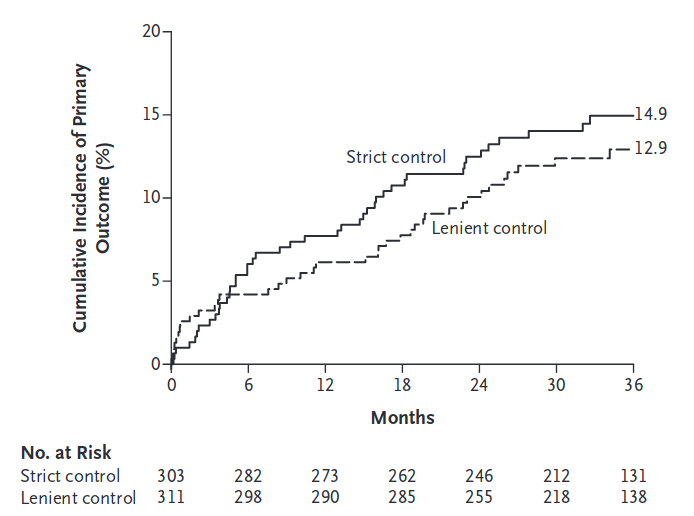
Lenient versus Strict Rate Control in Patients with Atrial Fibrillation. N Engl J Med 2010;362:1363-73.
AV node ablation
- Simple method of rate control
- Consider in selected patients
- VVI or CRT pacing depending on LVEF
Achieving and maintaining sinus rhythm - Rhythm control
Reversible conditions with AF
- Hypertension (1)
- Thyroid dysfunction
- Obesity (2)
- COPD
- Obstructive sleep apnea
- Smoking
- Alcohol
- Cardiorespiratory fitness (3)
- Scheider et al. Prevention of Atrial Fibrillation by Renin-Angiotensin System Inhibition: A Meta-Analysis. JACC Volume 55, Issue 21, 25 May 2010, Pages 2299-2307
- Abed HS et al. Effect of Weight Reduction and Cardiometabolic Risk Factor Management on Symptom Burden and Severity in Patients With Atrial FibrillationA Randomized Clinical Trial. JAMA. 2013;310(19):2050–2060. doi:10.1001/jama.2013.280521
- Pathak RK et al. Impact of cardiorespiratory fitness on arrhythmia recurrence in obese individuals with atrial fibrillation: The CARDIO-FIT study. J Am Coll Cardiol 2015; 10.1016/jack.2015.06.488
Weight reduction in AF
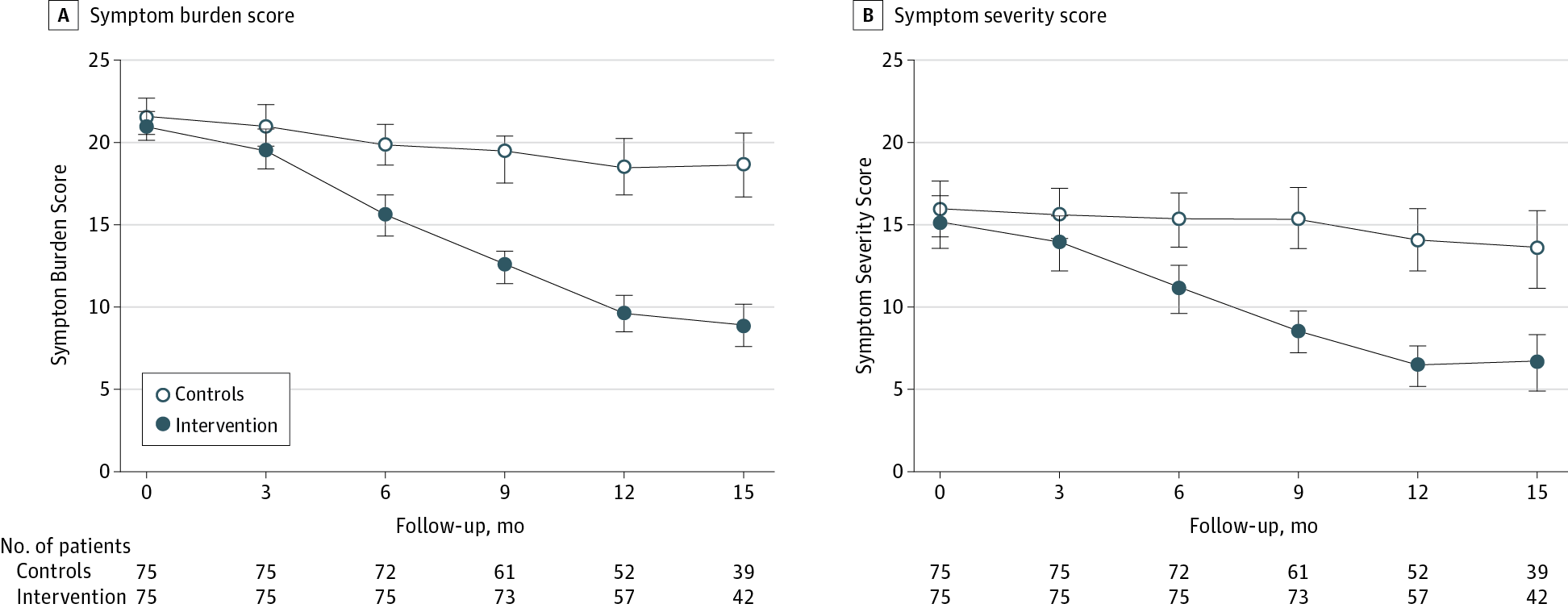
Abed HS et al. Effect of Weight Reduction and Cardiometabolic Risk Factor Management on Symptom Burden and Severity in Patients With Atrial FibrillationA Randomized Clinical Trial. JAMA. 2013;310(19):2050–2060. doi:10.1001/jama.2013.280521
OSA treatment and PVI outcomes
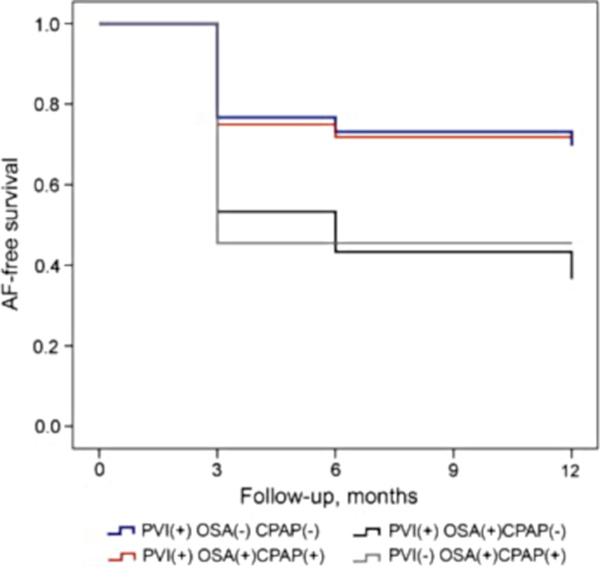
Treatment of Obstructive Sleep Apnea Reduces the Risk of Atrial Fibrillation Recurrence After Catheter Ablation. Journal of the American College of Cardiology Volume 62, Issue 4, 23 July 2013, Pages 300-305
Risk factor management and outcomes in AF ablation
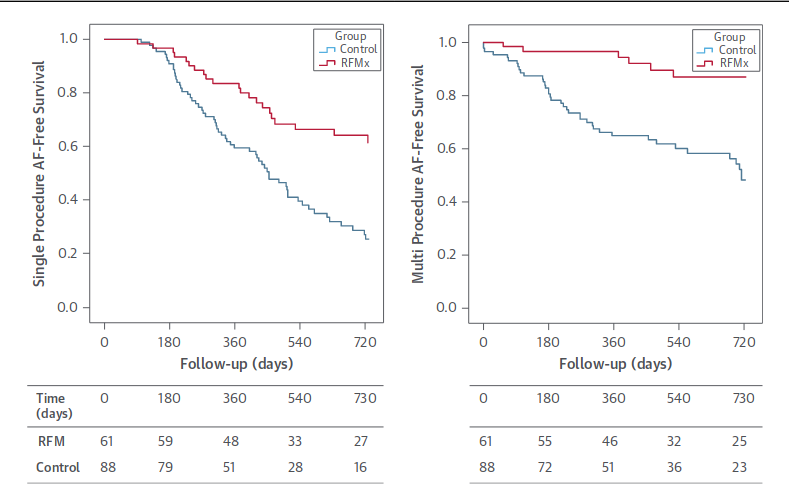
Pathak, R. K. Aggressive risk factor reduction study for atrial fibrillation and implications for the outcome of ablation: The ARREST-AF cohort study. JACC 2014, 64(21), 2222-2231. DOI: 10.1016/j.jacc.2014.09.028
Anti-arrhythmic Drugs
- Ibutilide - For acute conversion
- Flecainide
- Long term treatment in structurally normal heart
- Pill in pocket approach
- Loading / establishment of safety in hospital
Catheter Ablation of AF
Technique
- Pulmonary vein isolation at atrial level
- Extended ablation - insufficient data, higher risk
- Additional lines
- CFAE ablation
- "Rotor" ablation
Pulmonary vein isolation
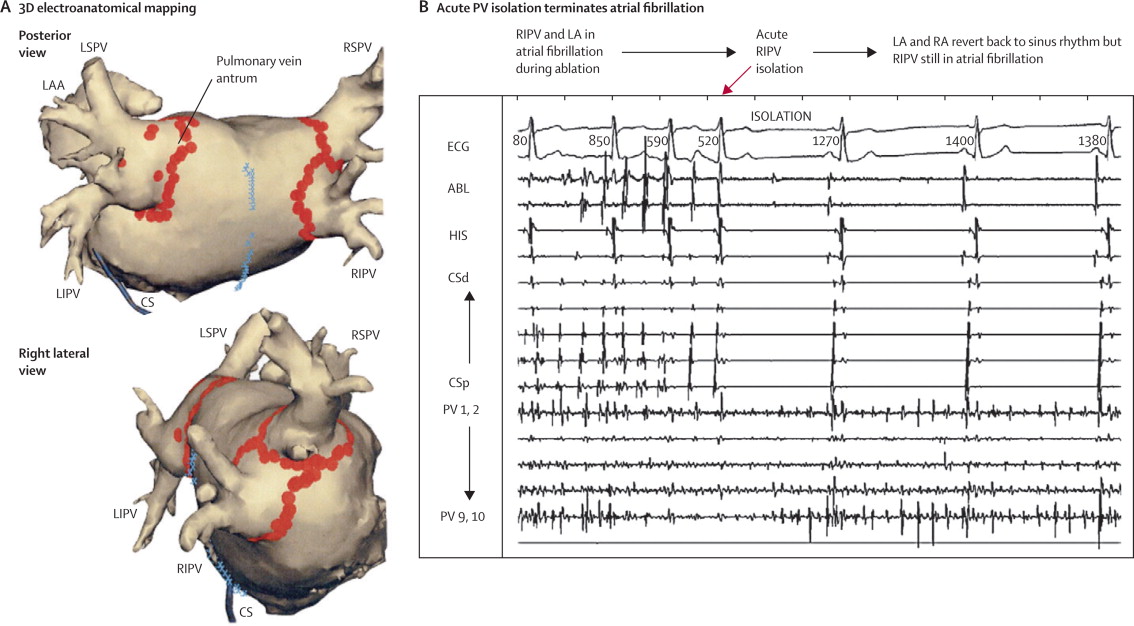
Paroxysmal AF - Ablation as initial strategy (vs class Ic / III drugs)
- Somewhat better than drugs
- Freedom from AF at 2 yrs - 85% / 71%
- 146 patients - 1 death (procedure related stroke), 3 tamponade
Nielsen. MANTRA PAF - Radiofrequency ablation as initial therapy in paroxysmal atrial fibrillation. N Engl J Med. 2012 Oct 25;367(17):1587-95
MANTRA PAF. Small difference in outcomes. Worth the complication rate?
Ablation vs drugs for persistent AF

Mont L … Brugada J; SARA investigators. Catheter ablation vs. antiarrhythmic drug treatment of persistent atrial fibrillation: a multicentre, randomized, controlled trial (SARA study). Eur Heart J. 2014 Feb;35(8):501-7. doi: 10.1093/eurheartj/eht457
Rhythm control - will ablation make a difference?
- EAST AFNET
- Will early comprehensive rhythm control improve outcomes
- Recruitment completed in 2016
- CABANA (1)
- Ablation vs drug therapy for new onset AF
- No difference in outcomes at 5 years (death / stroke)
Presented at ESC congress and HRS 2018
What to expect
- Most patients require more than one procedure
- Freedom from severe symptomatic AF recurrence
- Paroxysmal AF - 70%
- Persistent AF - 50%
- Severe complications - 5-7% (1)
- Does not reduce thrombo-embolic risk
- Shared, informed decision making
Cappato et al. Updated Worldwide Survey on the Methods, Efficacy, and Safety of Catheter Ablation for Human Atrial Fibrillation. Circ Arrhythm Electrophysiol. 2010;3:32-38
AF and heart failure
AF with HFrEF
- Beta blockers / Digoxin for rate control
- CRT candidates benefit with AV nodal ablation
- AF ablation may be beneficial (1)
- A randomized trial to assess catheter ablation versus rate control in the management of persistent atrial fibrillation in heart failure. J Am Coll Cardiol 2013; 61 :1894 – 1903.
AF Ablation in HFrEF
- Technically more demanding
- Reduces AF recurrence (1)
- Improves outcomes (2)
- May improve LV function
- Ablation vs. Amiodarone for Treatment of Persistent Atrial Fibrillation in Patients With Congestive Heart Failure and an Implanted Device: Results From the AATAC Multicenter Randomized Trial. Circulation ;doi:10.1161/CIRCULATIONAHA.115.019406.
- CASTLE-AF Investigators. Catheter Ablation for Atrial Fibrillation with
Heart Failure. N Engl J Med. 2018 Feb 1;378(5):417-427
Tachycardia induced cardiomyopathy
- Arrhythmia in first reported case in 1913
- Heart failure / LV dysfunction often attributed to other causes
- Irregularity of response may contribute ?
- High index of suspicion to diagnose
- LVEDD < 66 may predict TIC (1)
- Rhythm control strategy preferred in tachycardiomyopathy
- Jeong YH et al. Diagnostic approach and treatment strategy in tachycardia-induced cardiomyopathy. Clin Cardiol. 2008;31:172–178
Integrated AF management
Integrated management approach
- Multidisciplinary AF team (AF Heart team)
- Role for non-specialists
- Patient involvement
- Structured follow up
Integrated management
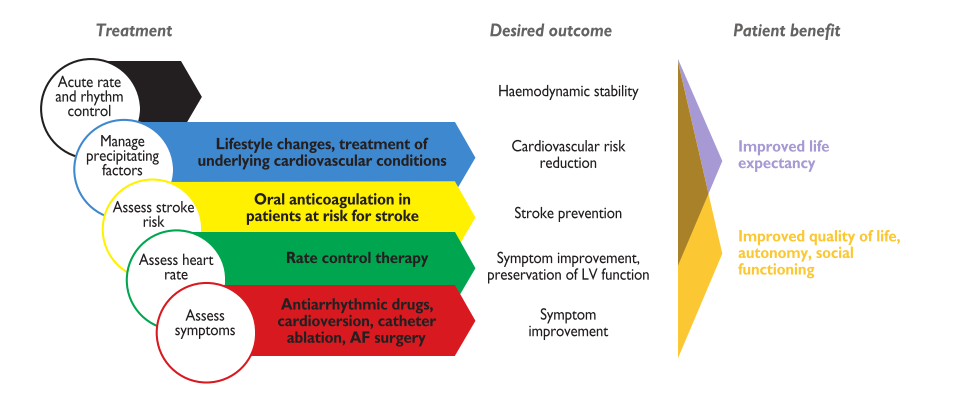
Goal based management
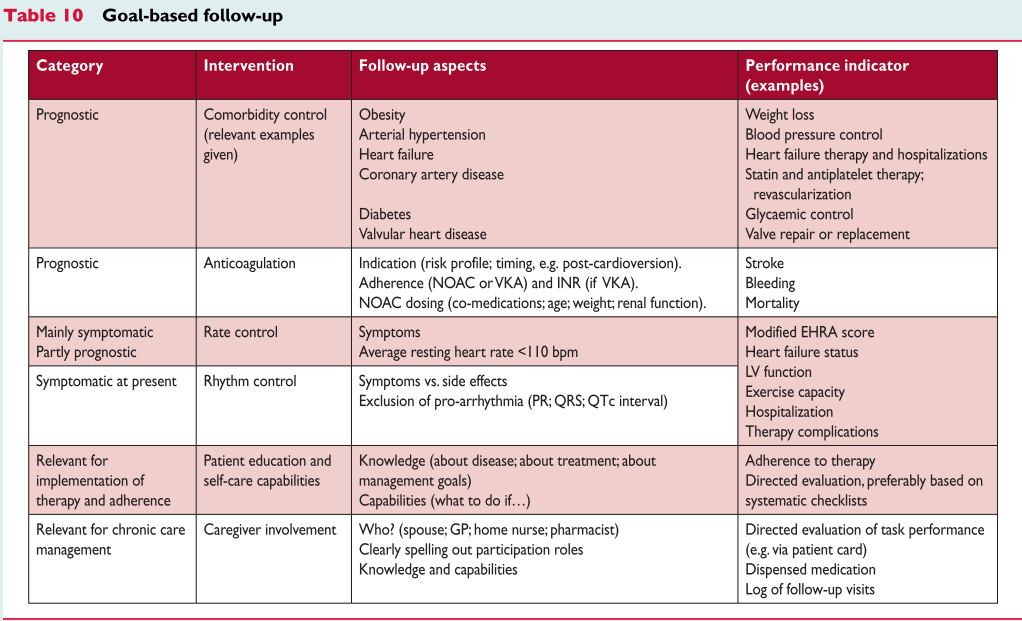
Summary
- AF is a disease with a multifactorial pathogenesis
- Needs a multi-pronged approach to treatment
- Integrated management with team approach
- Lifestyle and drug management are still key
- Ablation has a role in selected patients